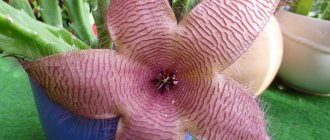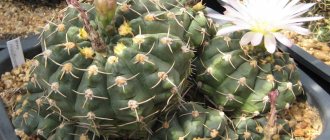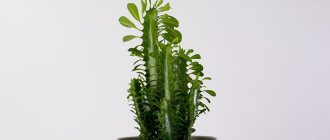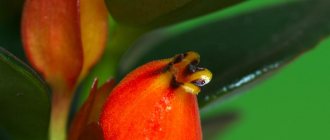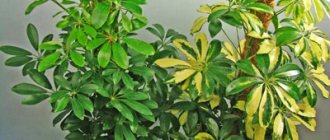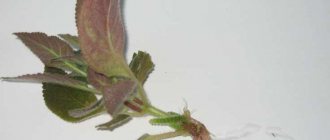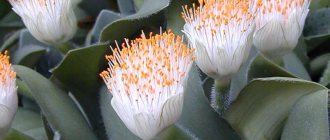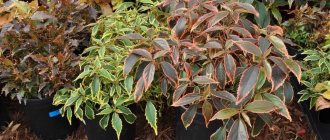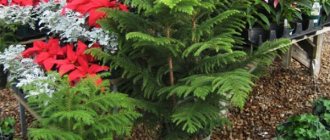Davallia is a perennial fern plant famous for its rapid growth rate.
She belongs to the Davalliev family. In everyday life, this shrub is also called “rabbit’s foot” or “deer’s foot.” It grows in the Australian and Asian tropical zones, in Japan and China, the Canary Islands, and also on the island of Java. Due to the appearance of Davallia, it is classified as an exotic plant species. The homeland of Davallia is the Fiji Islands, Tropical Asia. The plant belongs to the genus of perennial epiphytic ferns of the Davalliaceae family, named after the botanist from Switzerland E. Daval. It differs from other ferns in its attractive shaggy-hairy rhizomes (brown or silver in color), hanging over the edge of the container in which it grows. Because of this feature, floriculture experts call Davallia “hare’s foot.”
Plant growth can vary from 10 to 20 cm. Davallia goes through developmental phases quite quickly and is characterized by intensive growth. Like other varieties of ferns, hare's foot does not bloom. Dawallia's finely pinnate foliage can reach approximately 15cm in length. It is evenly dissected and colored rich green. The leathery frond has the shape of a triangle.
| In one season, the plant doubles in growth. |
| Davallia does not bloom. |
| The plant is easy to grow |
| Perennial |
Useful properties of Davallia
The main beneficial property of the plant is to humidify indoor air. It filters harmful substances, performing the functions of a “green liver”. Davallia combats physical, chemical and biological air pollution. It feeds on gases that are hazardous to human health. The plant has a sound-absorbing effect.
Soil requirements and fertilizers
Ferns require slightly acidic soil.
It is best to choose a slightly acidic soil substrate for the fern in question. You can compose it from:
- 1 part turf land
- 1 part sphagnum
- 1 part coarse sand
- 2 parts peat soil
- 2 parts leaf soil
- Handfuls of charcoal
Another option that takes into account the epiphytic nature of the plant as much as possible (the components are taken in equal proportions):
- Sphagnum moss, finely chopped
- Small pieces of pine bark
- Crushed charcoal
- Purchased soil for bromeliads
- Peat
You can also grow dawllia in orchid substrate.
Important - under no circumstances should creeping fern roots be removed.
It is best to feed the plant with fertilizer for decorative foliage, diluted half with water, only from May to August, once every two weeks, separately from watering.
Indoor ginura is an interesting plant for your home. For detailed information, follow the link How to grow indoor pomegranate, you can find out here.
Davallia: care at home. Briefly
| Temperature | In summer – 15-25°C, in winter – at least 13°C. In summer, the room with the plant should be ventilated. |
| Air humidity | High. The plant needs to be sprayed with warm and soft settled liquid approximately twice a day. |
| Lighting | Bright diffused or semi-shaded. The best option would be a window in the eastern part of the room. |
| Watering | Abundant but infrequent. During the moistening procedure, liquid should under no circumstances fall on the rhizome. |
| Priming | Loose, air- and water-permeable. Suitable soil that contains peat, leaf soil and sand. You should also mix the soil with sphagnum, pine bark and charcoal. |
| Feeding and fertilizer | In spring and summer, feed the plant with weakly concentrated fertilizer twice a month. |
| Transfer | Young ferns need to be replanted once a year, mature ones - once every two years. |
| Reproduction | Seeds are germinated under film at a temperature not lower than 25°C. The time for the first leaf to appear is 2-3 months after sowing. |
| Features of cultivation | In summer you can take it out into the open air. Shade from direct sun. |
Features of growing Davallia
Davallia is not picky at home and is quite easy to care for. The main thing is to fulfill all the conditions for watering, fertilizing, transplanting, temperature, humidity level and lighting. If the owner follows them, the plant will delight him with lush foliage and shaggy tangles of roots.
Choosing a location for the dawliya
Place the dawllia in a place where there is diffused light.
Dallalia fern prefers a sunny place with diffused light and without direct sun rays. The best summer option is an east-facing window, where light falls mainly in the morning, or a north-west window. In the south or west, the fern will need shading, and in the north it will suffer from a lack of light.
The best temperature for the plant in summer is from 18 to 22 °C, and in winter - from 15 °C and above. It is important to remember that dalliya does not tolerate drafts. If the temperature is too low, the plant may lose all its leaves, but in this case there is a chance that it will grow new ones in the spring.
Davallia: care at home. Details
Davallia blooming
Ferns of all varieties, including this one, never bloom.
Temperature
In summer, the plant can exist in a room where normal room temperature is maintained (from +16 to +25°C). During the cold season, the fern begins to adapt to low temperatures, but if it falls below +13°C, Davallia's foliage will begin to die off.
Spraying
The best air humidity level for Davallia varies between 50-60%. Despite the fact that this variety of fern can adapt to dryness, it should still be sprinkled with water from time to time. The plant can also be placed in a tray with moistened expanded clay. This condition is especially important during the summer heat or winter when the heating is on.
Lighting
Household Davallia, like other indoor plants, needs bright, diffused lighting. The ideal option for it would be a window in the eastern part of the room. Like all varieties of fern, hare's foot does not need direct sunlight, but complete shade can adversely affect its development. However, the plant is quite suitable for artificial lighting.
Watering
Davallia fern at home should be provided with infrequent but abundant watering. In summer, the plant should be moistened approximately once a week.
For these purposes, soft and settled liquid should be used. During hot periods, the frequency of watering should be increased, and during cold periods, it should be reduced. When caring for Davallia at home, you must not allow the soil clod to dry out. During the break between watering procedures, only the surface layer of soil (about 3 cm) should dry out. If this condition is not met, the foliage of the plant may dry out and fall off.
Ferns also do not like excessive moisture. Floriculture experts advise watering Davallia using the immersion method. Only it is suitable for those cases when the “paws” grow to such an extent that watering the soil in the usual way becomes impossible.
Pot for Davallia
The plastic pot is lightweight and easy to handle. However, clay containers can last much longer. After some time, the plastic begins to crack. A clay pot absorbs excess moisture and gives it to the plant when it needs it. Its main disadvantage is its susceptibility to fungus, which cannot be eliminated. The plastic container is airtight and does not retain moisture.
That is why the best option for Davallia is a clay pot.
Soil for Davallia
The soil in which the fern grows must be loose and water permeable. The best option is a mixture of peat and leaf soil. If you use store-bought soil, it should be mixed with perlite, vermiculite, sphagnum and pine bark (1 cm). Davallia is not suitable for soil that is too dense, as this slows down its development. When growing this fern, be sure to use a drainage layer.
Feeding and fertilizer
This type of fern is not demanding of fertilizers. From the beginning of spring to the end of summer, it should be fed with a weakly concentrated mixture intended for ornamental foliage plants twice a month.
Davallia needs periodic washing in the shower. During this procedure, you need to avoid getting liquid on the rhizome and soil.
Davallia transplant
The plant must be replanted once a year while it is in the initial stages of development.
Mature Davallia should be replanted less often, approximately twice a year. The procedure should occur in early spring. For this you need to use a low pot with a centimeter drainage layer at the bottom. When replanting, it is important to pay attention so that the shaggy root system of Davallia is not buried, but remains on the surface.
Fern pruning
Davallia is characterized by a neat, compact, original and graceful shrub shape that does not require pruning. It is necessary to get rid of only diseased, dried and withered leaves, carefully cutting them off near the base.
Rest period
The dormant period begins in September and continues until early spring. At this time, the fern leaves begin to turn yellow and dry out. Caring for Davallia at home during this period should be limited to minimal watering to prevent the soil from drying out.
If on vacation
If the vacation lasts no more than 10 days, then it will be enough to simply water the plant before leaving. Otherwise, it is better to ask friends to care for the fern.
What davalia looks like - characteristic features of the plant
Davallia is an epiphytic fern. It can be distinguished from other types of ferns by the structure of the root system. Only davalia has part of its roots that live outside the pot, beautifully hanging from the walls of the container. This feature of the plant allows it to be grown as an hanging crop in hanging pots. However, the epiphyte feels great even without a pot, having settled on a tree support and entwined its roots. The aerial roots are very beautiful and thick. At the base they are covered with a kind of scales, and along the entire length with soft silver or brown fluff. If a fern grows in a pot, the roots hang down and entwine it, and they can also spread along the surface.
Due to the pubescent surface of the roots hanging from the pot, davallia is also called the hare's foot fern. They really look like animal paws, and also like spider legs.
Otherwise, davallia grows like all ferns. Its aerial part consists of many openwork leaves with jagged segments. They appear in the spring-summer period, and in the winter the bush suspends its development. Adult ferns are very lush, with a wide crown, but on average about 20 cm in height, although there are specimens up to 50 cm. At the same time, the length of the aerial roots in some species of davallia can reach up to 90 cm.
The fronds are capable of changing their color. At a young age they are bright green, but gradually acquire a yellowish tint.
Growing Davallia from spores
Ferns can reproduce by spores. This method takes quite a lot of time.
Spores form on the foliage of mature plants. They need to be shaken into a paper envelope and placed in a dry, dark place. Next, they need to be sown in a shallow container filled with loose sterilized soil and covered with glass. They should be exposed to diffused light.
Spores germinate at room temperature. This usually takes from 2 to 6 weeks. Any growths that appear should be carefully sprayed and continue to be stored under glass. After about 2 months, when young bushes appear, the peat needs to be divided into parts and planted. It is better to place them in a closed aquarium to tame them to dryness.
Diseases
Usually davaliya starts to hurt due to improper care. If you water the plant too much and too often, rot may occur. In this case, the rot is cleaned from the roots and the watering regime is reduced.
Davallia can also get a fungus. At the initial stage of the disease, the affected parts must be cut off and the wounds sprinkled with ash. In this case, it is necessary to treat the plant with a special preparation.
The plant can be attacked by various pests - aphids, scale insects, mites. Pests must first be removed manually or using a shower. Then the plant is treated with special pest control agents.
Davallia will become an unusual and exotic decoration for any apartment. The lush appearance and roots growing outward will not leave davaliya without attention. Even the most inexperienced gardener can cope with growing the plant.
Reproduction of Davallia by division of rhizomes
Davallia is most easily propagated by division. To do this you need to cut the bush. New plants must be planted in separate containers, having previously sprinkled the sections with crushed coal.
To get many bushes, the Davallia root system should be cut into pieces about 6 cm long (each piece should have at least one leaf). Then they must be placed on the surface of the earth in another container and secured with wire. When roots and leaves appear on the pieces, they need to be planted in different pots.
Description of the plant
Davallia is interesting for its reddish, hairy rhizomes. The roots are thick, fleshy, covered with scales of various shapes, “crawl” out of the pot and are very reminiscent of a “hare’s foot” or “deer’s foot.” They cannot be cut. For this feature, the plant received its popular names. The length of the rhizome reaches ninety centimeters. The height of the plant is no more than fifty centimeters.
Florists are interested not only in the roots of the plant, but also in the leaves (fronds, as botanists call fern leaves), triangular, pinnately dissected. From ten to thirty centimeters in length, reaching ten to twenty centimeters in width. Davallia leaves are bright green with a leathery surface. Petioles are brown in color with a glossy surface.
Davallia is a sporous plant, so its leaves have sporangia, organs that produce spores. Sporangia are located at the top of the leaf and are spherical in shape. Spores replace flowers for the plant. However, they are dangerous for people with asthma and can cause allergies.
Diseases and pests
Ferns of this variety may be subject to the following problems:
- The foliage of the dawllia fern dries out - the temperature level is too low.
- Dawllia leaves die and turn yellow due to low humidity levels in the air.
- Davallia leaves curl - the plant does not have enough moisture.
- Davallia turns yellow and sheds segments - excessive soil moisture.
- Brown tips of davallia leaves and dying yellowed foliage are a sign of increased temperature and dry air.
- There are burns on the leaves of dawllia due to excessive lighting.
- Davallia roots rot due to too frequent procedures of abundant soil moisture.
Davallia can be affected by the following pests:
- thrips;
- scale insect;
- spider mite;
- mealybug;
- aphid;
- whitefly
Difficulties in growing the plant
Photo of indoor Davallia flower
- If the leaves of Davallia darken and dry out, this means that the air in the room is poorly humidified, or this is due to elevated temperature conditions in the room.
- Yellowing, curling, falling off of leaves, wilting too quickly and falling off of young leaves - this means that the air in the room has a low temperature, and these symptoms are also observed when watering the plant with cold water and in cold drafts.
- The leaves of the Davallia flower wilt and turn pale gray due to very intense sunlight.
- In the winter season, the leaves of Davallia turn yellow and dry out - this is normal for winter, when the spring season comes, the leaves will appear again.
Types of Davallia domestica with photos and names
This genus of plants includes approximately 50 varieties of herbaceous epiphytic ferns. They are widespread in the Australian and Asian tropical regions.
Davallia dissecta
This type of herbaceous epiphytic fern has a powerful creeping rhizome system, which is covered with a large number of light brown scales. The length of the foliage reaches 3 cm. It is placed on small petioles of straw color.
Davallia canariensis
The creeping aboveground rhizome system of this variety of herbaceous epiphytic plant is covered with dense pubescence, which is colored light brown. Because of this, Davallia canariana received another name - “deer leg”. Fern foliage is similar in appearance to carrot foliage.
Popular types of epiphytic fern
The Davalliaceae family, to which the epiphyte belongs, is very small. It has about 4 dozen ferns, which differ in the size and shape of the fronds. But due to their demanding nature, most species grow only in the wild.
Only a few, the most unpretentious, ferns have taken root in indoor floriculture, including:
- Davallia is dense. The leaves are three times pinnate, quite dense, looking like wide triangles on long petioles. The height of the frond is up to 50 cm with a width of up to 25 cm.
- Canarian dawllia. The fronds are openwork, pinnately dissected four times, similar to an elongated rhombus. The length of the leaf is almost equal to the length of the petiole (about 30 cm).
- Davallia vesiculata. It is distinguished by its spiral-shaped roots, colored brownish. The leaves are slightly swollen, up to 25 cm long and about 15 cm wide.
- Fijian dawllia. One of the tallest and darkest ferns, capable of growing up to 90 cm. But it has thin but strong petioles that hang beautifully from a hanging pot. Another feature of the species is the ability to annually renew fronds, getting rid of old ones.
- Davallia dissected. Herbaceous species, one of the lightest. The petioles are yellow-green with shiny leaves about 30 cm in length.
How to help a plant adapt to an apartment?
In order for dalia to take root well on the new pestle, several steps should be followed after acquisition.
- After purchasing, be sure to check the food for diseases and pests.
- Place the plant in a shaded room and gradually acclimate it to a constant level of light over several days. The fact is that dalia easily tolerates shade, but in high light conditions the fern leaves grow thicker
- Spray the foliage with warm water from a spray bottle.
- Moisten the soil in the pot thoroughly.
- In the first two weeks, you should keep dalia away from other plants, setting up a kind of quarantine. During the same period, give your green pet preventative treatment against insects.
Problems growing?
Davallias are quite stable and only get sick if they are given improper and unstable care. Usually the cause of all troubles is the irrigation regime.
If the dawllia crumbles...
Leaf fall is characteristic of all ferns in conditions of too dry air. In this case, loss of foliage is inevitable. It is especially difficult for epiphytes in winter, when they require regular daily moisture. You can spray them several times a day, or install a humidifier nearby, fill the tray with water, and take frequent showers. Do not place ferns near radiators or heaters; be sure to ventilate the room.
If davallia loses its decorative effect...
The second most important component of care is light. Its absence affects the appearance of not only ferns
In strong shade, a weakened plant with pale leaves is formed. You can restore decorativeness by trimming and obligatory replacement of the place.
Loss of brightness and foliage may be a reaction to some changes: a strong jump in temperature, dryness, or the use of new drugs. In any case, you should analyze the condition of the soil and spray the flower with the addition of an immunomodulator, such as “Epin”, “Stimul”.
We should not exclude pests, for example, spider mites, which love deciduous plants. This article will help you identify him.
The dallalia fern is one of the most beautiful representatives of ornamental flora. Perhaps now you too will decide to acquire such a plant.
